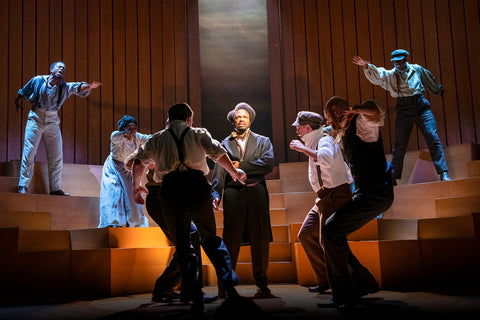
Before Literary Stardom, Frederick Douglass Faced a Life of Violence
Frederick Douglass was the most photographed American of the 19th century. He knew the power of visualization and sat for more than 160 photographic portraits. Douglass is again in the public eye with a Pulitzer Prize–winning biography, an HBO documentary, and a film produced for distribution by the Public Broadcasting System. It should come as no surprise, then, that he is now the subject of that most American of theatrical formats: the musical.
But American Prophet, recently staged by the Kreeger Theater, part of the Arena Stage in Washington, D.C., one of the nation’s most prestigious regional theaters, is not your typical song-and-dance musical. Like the widely acclaimed and better-known _Hamilton, _ the retelling of the first half of Douglass’ turbulent and often violent life departs from the realm of tuneful fancy into the more exacting realm of history. Using Douglass’ actual language drawn from a plentiful archive of his speeches, letters, journalism, and autobiographies, Hummon, a Grammy Award winner, and Randolph-Wright, an award winning playwright, reveal the poetry and power of the rising abolitionist, orator, journalist, and author and challenges the audience to see that the discrimination and racism Douglass endured throughout his life continue in society today.
GET HISTORY 'S GREATEST TALES—RIGHT IN YOUR INBOX
Subscribe to our HistoryNet Now! newsletter for the best of the past, delivered every Wednesday.
Close
Thank you for subscribing!
Submit
While the musical is primarily set between 1851 and 1865, Douglass’ early years are presented in flashbacks that include his childhood in Talbot County, Md., his escape to New York City in 1838, his settlement in New Bedford, Mass, and his growth as an recognized spokesman for abolition and racial equality. Cornelius Smith Jr. who portrayed Douglass in the Kreeger production, is a riveting presence on the show’s minimalist, wood-paneled set. His soulful voice and and hauntingly powerful eye contact with the audience makes Douglass a compelling and complex character that demands attention and respect. Nowhere is this more evident than in the rousing song that ends the first act, “We Need a Fire.” Sung by Douglass and the show’s ensemble, it is the production’s signature anthem and is drawn from Douglass’ famous 1852 “What to the Slave is the Fourth of July?” speech, delivered at Corinthian Hall in Rochester, N.Y.
Douglass isn’t the only character commanding attention. Hummon and Randolph- Wright bring to life Douglass’ wife, Anna Murray, a constant and resolute partner often overlooked by history because she chose to remain in the shadow of her illustrious husband. Kristolyn Lloyd poignantly portrays Anna, a free Black woman from Caroline County, Md., a conductor on the Underground Railroad, and a bona fide historical heroine in her own right. She met Douglass at a dance in Baltimore in 1838, urged him to persevere in his flight to freedom, later served as his business agent, and raised five children during their 44 years of marriage while her peripatetic husband spent most of his time on the road. Their steely yet affectionate bond is reflected in the yearning beauty of “Children of the Same River,” a song acknowledging that the struggle for freedom and racial justice will consume both their lives.
American Prophet also depictsthe complicated relationships Douglass had with three other important historical figures: William Lloyd Garrison, John Brown, and Abraham Lincoln. Chris Roberts plays Brown with an impatient vitality worthy of the firebrand abolitionist. He joins Douglass in “We Need a Fire” and is given a much deserved solo in “Hands” as he prepares for his ill-fated Harpers Ferry raid. Thomas Adrian Simpson portrays both Garrison and Lincoln. Some critics have found fault with how Lincoln is portrayed and with Douglass’ meeting with the president. But these are easily overlooked quibbles in an otherwise praiseworthy production that challenges the audience to look into their own hearts and grapple with the complex issues and emotions portrayed.
In a recent interview, Randolph-Wright presciently reflected, “We need to understand where we’ve been to deal with where we are and where we’re going.” He hopes his show will soon be going to Broadway, where it deserves to garner large audiences and rave reviews.
